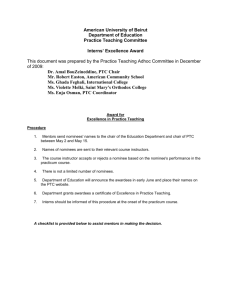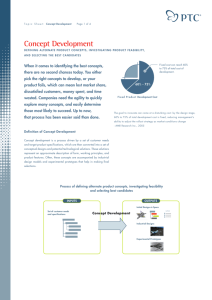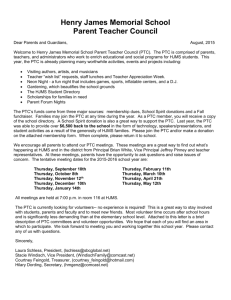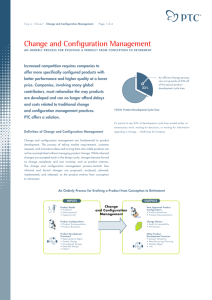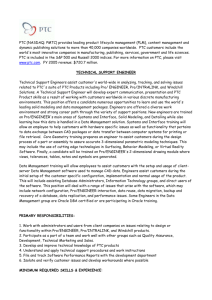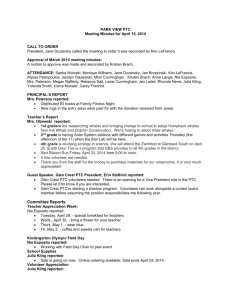Top-Down Design - PTC/USER Benelux
advertisement
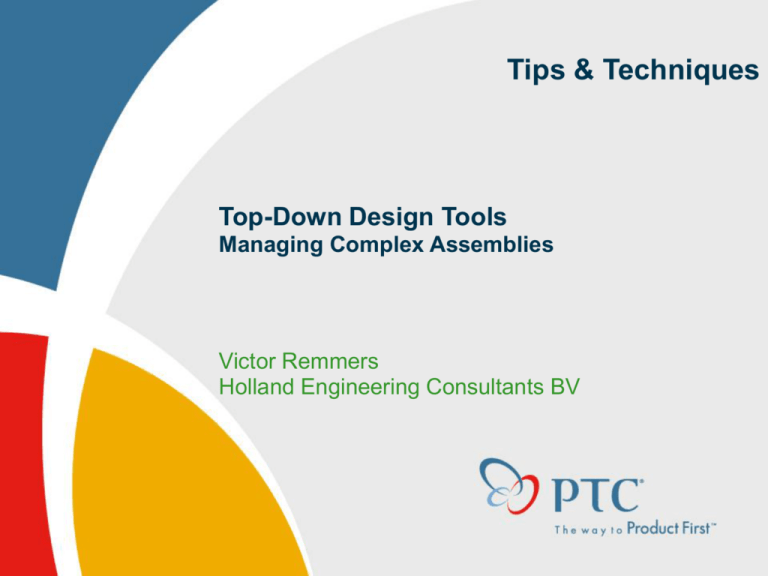
Tips & Techniques Top-Down Design Tools Managing Complex Assemblies Victor Remmers Holland Engineering Consultants BV Top-Down Design Philosophy 2 © 2006 PTC Traditional Design Approach “Bottom-Up Design” Design of individual components independent of the assembly Manual approach to ensure that components fit properly and meet the design criteria Components and those placed in sub-assemblies are brought together to develop the top-level assembly Errors are manually identified and modifications to each component are made to make the adjustment. As assembly grows, detecting these inconsistencies and correcting them can consume a considerable amount of time Top Level Assembly Component Design 3 Component Design Component Design © 2006 PTC Possible example Bottom Up? Mate 4 © 2006 PTC Top-Down Design Philosophy “Top-Down Design” Method of placing critical information in a high-level location Communicating that information to the lower levels of the product structure Capturing the overall design information in one centralized location Design Information Component 5 Component Component © 2006 PTC A more integrated approach…. 6 © 2006 PTC Top Down Design Stages – It is a concept. 6-Stage Process 1. Conceptual Engineering Phase Layouts and Engineering Notebook 2. Preliminary Product Structure Phase Pro/INTRALINK, Model Tree 3. Capturing Design Intent Phase Skeleton Models 4. Manage Interdependencies Phase Reference Viewer & Reference Graph 5. Communication of Design Intent Phase Copy Geoms, Publish Geoms & Shrinkwrap 6. Population of the Assembly Phase Automatic Component Constraints & Component Interfaces 7 © 2006 PTC The Bobcat example 8 © 2006 PTC Stage 1 Conceptual Engineering Phase Layouts and Engineering Notebook Understand Existing Situation High-level Requirements Space Allocation Define New Space and Motion 2D Sketches 3D Models Rapid Iteration & Convergence Animations Capture Key Design Intent 9 Parameters Notes Spreadsheets Proprietary Data © 2006 PTC Stage 2 Preliminary Product Structure Phase Pro/INTRALINK, Model Tree Quickly define product hierarchy • Before any of the components’ geometry is defined Intuitive, automatic mapping to “start models” • Templates ensure all designs share the necessary common elements such as layers, views & parameters Foundation for efficient task distribution Assembly Population Environments 10 • Pro/E menus and Model Tree pop-up menus • Pro/INTRALINK and PDMLink Component Creation Methods • Empty Components; Copy from start models • Automatic assembly of default datums • Unplaced, Partially- & Over-Constrained Components © 2006 PTC Stage 3 Capturing Design Intent Phase Skeleton Models What needs to happen? Capture conceptual design parameters within the context of the assembly Capture & control critical object interfaces in a single, convenient location How? Skeleton Models… 11 Centralized pathway for communication Facilitate task distribution Promote well-organized design environments Enable faster, more efficient propagation of change Special Treatment in BOMs, Simplified Reps, Drawings, Model Tree & Mass Property Calculations Uniquely supported Scope Control Setting © 2006 PTC Stage 4 Manage Interdependencies Phase Reference Viewer & Reference Graph Tools to Manage References External Reference Control • Ensures Top-Down Design methodology is followed • Incorporate design management rules directly into the design • Ensures proper design reuse Pro/INTRALINK Model Tree Global Reference Viewer Reference Graph 12 © 2006 PTC Stage 5 Communication of Design Intent Phase Publish Geoms, Copy Geoms & Inheritance Publish Geometry Features Provides ability to pre-determine the geometry to be referenced by a Copy Geometry feature Allows designers to define their interfaces to the rest of the design Copy Geometry Features Allows copying of all types of geometry Surfaces, edges, curves, datums, quilts, copy/publish geometry Retains copied geometry name and layer settings Dependency on parent geometry can be toggled Can be “Externalized” External Copy Geometry Build relationships on external models independent of an assembly Useful for coordinate system assembly practices Inheritance – Inherit model geometry for one-way associativity Shrinkwrap (included in Foundation Advantage Package) 13 © 2006 PTC Stage 6 Population of the Assembly Phase Automatic Component Constraints & Component Interfaces What tools are available for populating the assembly? 14 Assembly Tools • Drag & Drop Placement • Component Interfaces Component Creation • Within the context of the assembly • Mirror Parts or Subassemblies © 2006 PTC How does Top Down Design relate to company goals? Four Goals from Upper Management 1) Cycle Time Reduction. 2) Increase User Satisfaction with Software. 3) Margin Increase. 4) Cost Reduction. 15 © 2006 PTC Why should you use it? Benefits: Reduced design time Reduced errors (right the first time) Increased quality Better project management visibility Concurrent engineering Confidence in top-level regeneration Knowledge of how modules interface Top-level change control 16 © 2006 PTC Example: to design an alternator... What information should a designer need to work with most times? Complete Top-Level Assembly 540 MB Neighboring Subassemblies 320MB All Skeleton Models in Top-Level Assembly 70 MB Subassembly, with Skeleton Model containing all required information ~ 20 MB 17 © 2006 PTC What does an example look like? Three Phases Pro/INTRALINK Pro/CONCEPT ISDX Pro/ENGINEER Pro/NOTEBOOK CONCEPTUAL DESIGN CAPTURE DESIGN CRITERIA DETAILED DESIGN 18 © 2006 PTC Product Definition 19 © 2006 PTC Product Definition: Engineering Layout What it is: First thing done in design cycle Used to evaluate key interface points Used to evaluate key components of project What it is Not: 20 Three dimensional solids Fully detailed © 2006 PTC Advantages of Using a Layout Document design information in one centralized location Document design information before creating solid models Investigate design options without involving the entire assembly Easily make design changes because all of the design information is contained in one location 21 © 2006 PTC #2 Product Definition: Assembly Structure What it is: Virtual Assembly / BOM Used to organize assembly & assigning of design tasks Used to input non-geometrical data up-front What it is Not: 22 Three dimensional solids Fully detailed Fully constrained © 2006 PTC Advantages of Defining Preliminary Product Structure Defining the product structure prior to defining geometry can assist you in organizing the assembly into manageable tasks that can be assigned to design teams or individual designers. Associate specific library parts (that are to be used on the project) with the assembly at the start of the design, preventing confusion later. 23 © 2006 PTC Advantages of Defining Preliminary Product Structure Cont… Submit the assembly to Pro/INTRALINK or PDMLink and assign models to the appropriate vaults or folders. Individual designers can focus on specific design tasks instead of on how their design is going to fit into the overall structure. Input non-geometrical information such as the part number, designer’s name, etc., at a very early stage. 24 © 2006 PTC #3 Product Definition: Skeletons What it is: Zero-mass geometry Exact location detail Minimized geometric detail What it is Not: 25 Three dimensional solids Fully detailed © 2006 PTC And Definitely Not This!! 26 © 2006 PTC Advantages of Using Skeletons 27 Provides a centralized location for design data Simplifies assembly creation / visualization Aids in assembling mechanisms Minimizes unwanted parent-child relationships Allows you to assemble components in any order Controls propagation of external references © 2006 PTC Central source for information Benefits of Communicating Information From a Central Source Task distribution Concurrent Modeling Managing External References Tools Declaration Publish Geometry Copy Geometry 28 © 2006 PTC Hierarchy Top_level.asm Top_level_skeleton.prt Sub_assy_1.asm Sub_assy_1_skeleton.prt Sub_assy_2.asm Sub_assy_2_skeleton.prt Sub_assy_x.asm Sub_assy_x_skeleton.prt 29 © 2006 PTC 3D Design … Finally! The foundation is set … but topologically modifiable … it’s time for 3D. With Reference Control Manager, you are safe to create your parts directly in the assembly. 30 © 2006 PTC More Than Meets The Eye! Interchangeability: 31 Family of Tables Interchange Assembly Layout Declarations © 2006 PTC Power of Top-Down Design To Achieve Advanced Automation, consider using: 32 Relations Pro/Program © 2006 PTC Miscellaneous Tips Separate Part Versus Assembly for Skeleton Features Avoid constructing assembly-level skeleton features since the system requires that you perform all edits of these features in Assembly mode. • The components can become an obstruction and degrade performance. • Furthermore, you cannot easily reuse skeleton features at the assembly level in other subassemblies. By using a separate part file, you can edit the feature in Part Mode and reassemble it into many different assemblies. Geometry Features 33 Place all static information in a skeleton as early as possible and place all dynamic information later in the design process cycle. © 2006 PTC Miscellaneous Tips Datums for Skeleton Models Consider renaming skeleton datums to “sk_” Visualization Use simplified reps and transparency prolifically to make viewing easier Use “display states” to highlight different items at different times Use surfaces to clarify meaning of centerlines & axes Conceptualization 34 Don’t be afraid to use simple hand sketches before delving into complex situations … it’s NOT illegal © 2006 PTC Pro/E Wildfire Enhancements High-performance Assembly Modeling Lightweight Components Represent common components with lightweight graphics for optimum display speed Accurate mass properties and BOMs Customizable symbolic representations Flexible Components Represent multiple states of a single component in an assembly Addresses critical need for consistency between BOM and assembly model Intelligent Regeneration 35 Assembly regeneration is up to 80% Faster! © 2006 PTC Highlights of Top-Down Design 36 Capture knowledge, or design intent, allowing you to concentrate on significant issues by making the software perform tedious, repetitive calculations. Enable the framework for interchangeability of components allowing for high-velocity product development by supporting rapid iterations of product variations. Create a concurrent design environment by spreading project design responsibility across many organizational levels. © 2006 PTC New in Advanced Assembly in Wildfire 3.0 Data Sharing Dashboard The Data Sharing dashboard consolidates the Merge, Cutout, and Inheritance features in a modern user interface. Enhancements to Data Sharing features in a new dashboard offer many benefits: 37 • Allows changing of multiple feature types at any point • Offers a user-friendly user interface with easy access to commands • Supports object-action workflow for increased productivity • Consolidates Data Sharing features, such as Merge, Cutout, and Inheritance © 2006 PTC New in Advanced Assembly in Wildfire 3.0 (#2) Top-Down Design with Mechanism Assemblies You can now design a skeleton model that includes motion. Motion skeletons are available in Assembly, allowing motion to be incorporated into the model at the beginning of the design process. There is no longer a need to recreate an assembly to include a mechanism analysis. You can create mechanism bodies and connections as a motion skeleton, then run a simple kinematic analysis to ensure that the skeleton provides the appropriate degrees of freedom. You can then create and assemble components to the motion skeleton. Motion skeletons are defined in the same way as normal assembly skeletons and include reference control settings. They do not appear in the assembly bill of materials. 38 © 2006 PTC POWER OF TOP DOWN DESIGN!!! 39 © 2006 PTC
